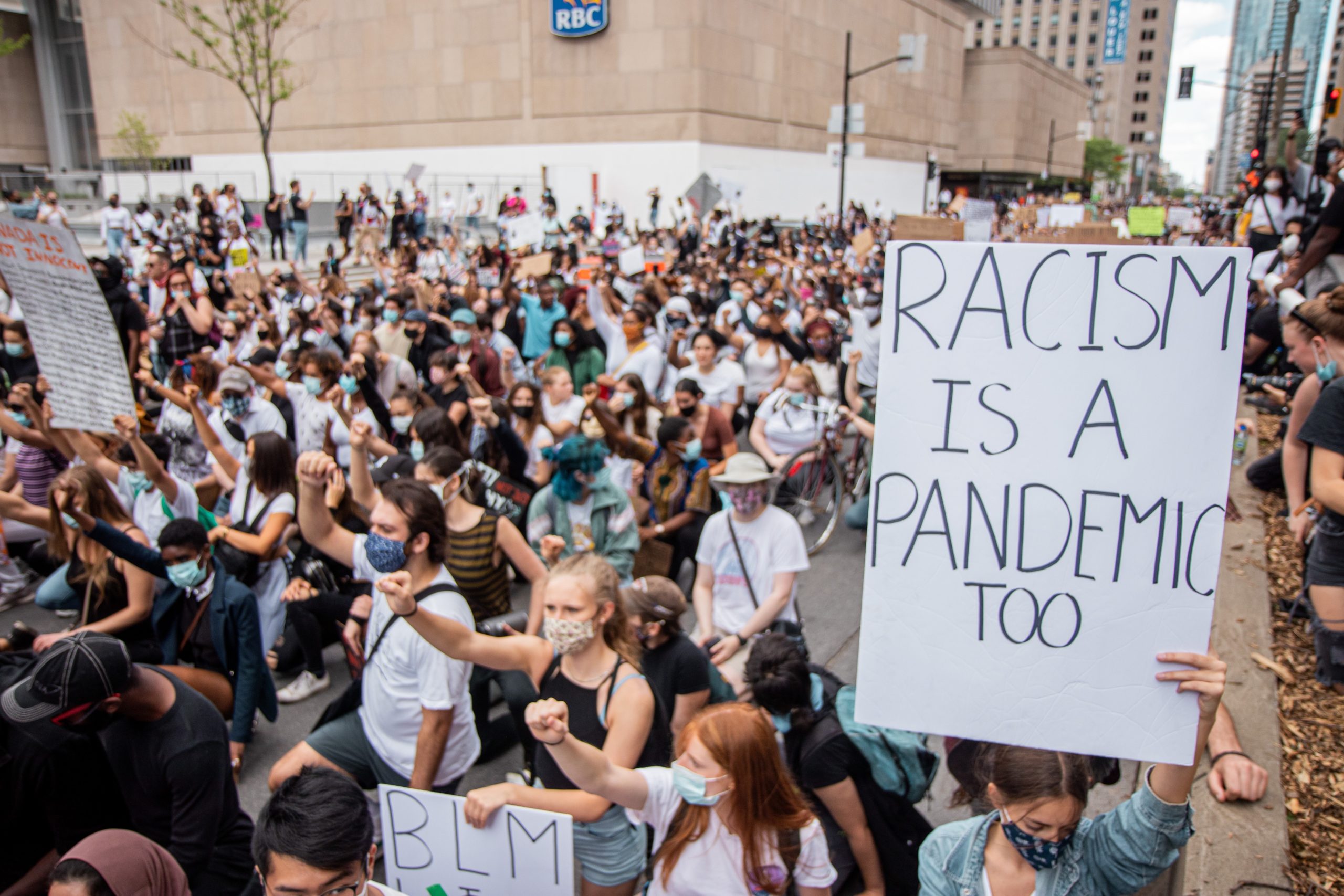by Romy Felsen-Parsons
*This series reflects on the impact of the COVID-19 pandemic on food insecurity and the right to food throughout the course of 2020 and pulls from varying cited materials throughout the course of the year. It has been sectioned into separate blog articles with an intention of paced readability without sacrifice to the integrity of the information and stories shared. Images used are sourced from the varying organizations and articles referenced in this series.
PART IV. THE IMPACT OF THE PANDEMIC ON THE FOOD SECURITY OF BIPOC COMMUNITIES
“During this ongoing crisis, minorities were more stressed about feeding their families because their struggle with food was not just temporarily triggered by COVID-19; rather, it is ‘a symptom of a social disease’, deeply rooted within our social systems.”
We have referenced, but as of yet have not delved deeper into, the structural racism that infiltrates our food systems and has led to BIPOC communities being disproportionately impacted by heightened unemployment and food insecurity since long before this health crisis. Utilizing a Right to Food framework would mandate that the government implement policies to directly address and combat barriers to success facing BIPOC communities so as to not only improve their economic, educational, employment, and health opportunities and outcomes, but to ensure these communities can flourish and reach their potential to the benefit of society as a whole.
Weekly data from the Census Bureau revealed that in 2018, 25% of Black households with children and 17% of Hispanic households with children were food insecure. Not only have rates of insecurity worsened across these groups during the pandemic, but the gaps between racial groups have widened, with Black and Hispanic households with children in the U.S. now being nearly twice as likely to be struggling to afford food during the coronavirus pandemic as white families with children. As Morales, Morales, and Beltran state in their recent academic study examining racial/ethnic disparities in household food insecurity in the context of the COVID-19 pandemic, “During this ongoing crisis, minorities were more stressed about feeding their families because their struggle with food was not just temporarily triggered by COVID-19; rather, it is ‘a symptom of a social disease’, deeply rooted within our social systems.”
This social disease manifests in a host of symptoms, including but not limited to “poverty, unemployment, incarceration, and disability,” as well as reduced access to housing, educational, and employment opportunities, “racial discrimination, exploitation, limited English-speaking proficiency, and lack of legal status,” all of which converge to create the trends of higher food insecurity and lower socioeconomic status among BIPOC communities. Of course, it is important to note that while these communities share the reality of being affected by social, economic, and political barriers, and fall under the umbrella of “BIPOC communities,” their experiences vary widely — for example, the challenges faced by Black communities due to anti-Black racism are entirely distinct from the challenges faced by undocumented immigrants within the Latinx community, by people of East Asian descent facing the model minority myth and a current rising tide of Sinophobia, or by Indigenous people in their struggle to have their land and political sovereignty acknowledged. While this article covers some of the common challenges and overlying structures, it in no way claims to be extensive or complete.
The racial wealth gap has been documented for decades and has existed within the bedrock of the American economy since the colonization of the continent. A recent report by the Harvard School of Public Health noted that in terms of socioeconomic status, 11% of Black and 9% of Hispanic households were poor, compared to 2% of white and 3% of Asian households. Pew Research Center further corroborates that the wealth of white households was 13 times the median wealth of Black households and 10 times greater than Hispanic households. Meanwhile, in terms of unemployment — the biggest indicator of food insecurity — Black people were still twice as likely to be unemployed than their white counterparts even before the pandemic began, and when employed earned lower than average wages in more insecure jobs. This gap has only widened since the pandemic began, now reaching its widest point in the past five years, with a rate of 15.4% unemployment of Black people compared to 10.1% among white people and slower rates of return to work.
While counties with the highest rates of food insecurity are overrepresented by counties with a majority Black population, Latinx individuals are among the most likely to be pushed into poverty as a result of pandemic-related unemployment. As we discussed earlier in this series, the gig and service economies are disproportionately upheld by Latinx workers, requiring them to risk their health for extremely low pay and usually no healthcare or benefits such as paid sick leave. At the same time, many of these workers are undocumented, thus prohibiting them from receiving financial assistance during the pandemic — and prior research has already indicated that fear of deportation might be one of the leading causes of food insecurity among Latinx households, especially those with immigrant members. Within our food systems, from agricultural farm hands to factory workers, Latinx people are overrepresented: the New York Times reports that “of the 5,721 workers in food processing, food manufacturing, and agriculture fields who tested positive for COVID-19 early in the outbreak, 72.8% were Latino, according to October 2020 data from the CDC.” About half of all crop hands — an underestimate that some state is really closer to 75% — in the United States, or more than one million workers, are undocumented immigrants, according to the Agriculture Department. Ironically, while many of these undocumented workers have not been laid off due to their being “essential workers” upon which the entire nation’s food systems rely, they still face the constant fear of deportation as they risk their lives to work in the fields. Thus, Latinx workers making unlivable wages as they bring the food to our tables are forced to make the impossible choice between their health and their food security, while being forced into poverty and facing the threat of deportation all at the same time.
At WhyHunger, much of the work we do around advocating for the right to food and supporting grassroots organizations connects food security to land ownership and to centuries of forced displacement and/or exploited labor imposed on BIPOC communities. We believe that land must reside in the hands of the community members and workers, be it by improving labor conditions and rights for agricultural workers, or supporting Black food sovereignty and Indigenous land campaigns. Incredible grassroots organizations are continuing their groundbreaking work in the face of COVID-19’s challenges: for example, the National Black Food Justice Alliance, one of the recipients of WhyHunger’s Rapid Response Fund, is building out a directory of Black food producers so as to shore up Black food supply chains for getting healthy food to Black communities and maintaining the livelihood of Black producers. Other organizations and grant recipients, like Comedores Sociales in Puerto Rico, the Hopi Permaculture Institute in Arizona, Our Kitchen Table in Michigan, and New York’s Campaign Against Hunger, are focusing their efforts on emergency food assistance and mutual aid for their communities. Still others, like the Farmworker Association of Florida and Familias Unidas por La Justicia Union in Washington, organize farmworkers and laborers to advocate for better working conditions, including health and safety precautions and a living wage.
The Right to Food framework, as we have made clear, is structured around the support for the most excluded and vulnerable communities. In this context, affirming the universal human right to food and affirming a commitment to prioritize racial equity work are one and the same.
Conclusion
So far, this series has discussed the Right to Food and threats to food security among various isolated populations, especially as a result of the pandemic. We have not yet stated the obvious yet crucial point that equitable food access cannot exist in a vacuum; rather, it is one element of the entire social, political, and environmental nexxus in which we live. As WhyHunger has stated since its founding, “When we look at the deeper, root causes and define hunger as a symptom, we can see the problem clearly as social injustice. And that is where we can begin to find real solutions to the complex economic, social and environmental issues at the source.”
The very first recommended action in the Voluntary Guidelines on the Right to Food adopted at the 127th Session of the FAO Council in November 2004 acknowledges the fact that equitable and sustainable food access can only exist in a society in which states “promote democracy, the rule of law, sustainable development and good (transparent) governance.” Education, human rights, and sustainable economic development must all simultaneously and progressively flourish. Individual participation in decision-making processes must be not only allowed but encouraged, as individuals and communities are the only ones who know with absolute certainty their needs and the solutions that will be most beneficial to meeting them.
Ultimately, while the Right to Food framework is addressed to states, it serves the purpose of reminding us all that governments are in fact beholden to their citizens. States are duty bearers and citizens are rights holders. While we must not allow this recognition to shift the burden of responsibility onto individuals for institutional failures, we must remember the incredible power we hold as individuals to shape the future we wish to see. And that power can most effectively be wielded through strong civil society organizations — especially social movements organized, led and sustained by those who, in the struggle for the right to food for instance, have been the most impacted by hunger and are forging solutions of their own as they struggle to hold the state accountable to its core function of protecting public health and welfare by upholding the indivisibility of human rights.
At WhyHunger, our Theory of Change and programmatic strategies reflect the belief that it will take resilient networks and alliances of grassroots leaders and community-based organizations working at the intersection of the root causes of poverty to end hunger. WhyHunger is committed to building and strengthening movements to transform our current food, farming and economic systems into those that nourish whole communities and advance the human right to nutritious food in the U.S and around the globe.
Romy Felsen-Parsons is WhyHunger’s former Programs Intern and Database Assistant. She is passionate about using communications to strengthen communities and help power systems change.







